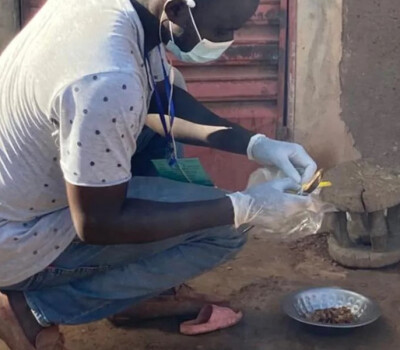ITM on the lookout for tiger mosquitoes

Tiger mosquitoes (Aedes albopictus) are small and fierce creatures. In addition to leaving painful bites, they can also transmit viral diseases such as dengue fever, chikungunya and Zika. The mosquitoes originally hail from South East Asia but have by now conquered Europe and America, due to international transport of goods, global warming and the mosquitoes’ own excellent adaptability. Tiger mosquitoes have lived in Southern Europe for several years now, and have now been seen in France’s Alsace region, too. Their habitat is increasingly moving north. Over the last few years, ITM has found a few tiger mosquitoes in Belgium, but so far the mosquitoes have not been able to survive our winters nor procreate. Tiger mosquitoes are regularly spotted in the Netherlands as well. In order to prevent the creatures from becoming regulars in Belgium, Belgian government agencies have established the Monitoring of Exotic Mosquitoes in Belgium (MEMO) project.
“Good monitoring will be crucial to preventing tiger mosquitoes from getting a foothold in Belgium. If we can map out in time where the mosquitoes are spotted, we will be better able to control them. We know where tiger mosquitoes are most likely to enter our country, and we will act as guard dogs there,” says Dr. Wim Van Bortel, a researcher with ITG and also the MEMO project’s co-ordinator.
Points of entry
The MEMO project will focus on 23 places across Belgium where the mosquitoes are likely to be “imported”. These are places where exotic mosquitoes may enter our country, such as tyre centres, garden centres, ports and airports. Being one of the world’s top-100 most invasive species, tiger mosquitoes will often hitch a ride with second-hand tyres and lucky bamboo plants. Stagnant water inside tyres, or water in which plants are transported, is the perfect place for these mosquitoes’ eggs. Airports and ports will be monitored, as well.
However, just because a few tiger mosquitoes have been spotted in Belgium does not mean we are facing a virus outbreak. “In themselves, tiger mosquitoes do not pose a threat. It is true they can transmit viruses from one human being to another. But for this to happen, a mosquito must first bite a person infected with the virus, before transmitting it to another person. Such viruses generally enter the country through an infected traveller,” says Van Bortel. Transmission of a virus requires the virus and a tiger mosquito to be in the same place at the same time. Generally, this only happens when the population of tiger mosquitoes is sufficiently large.
Project initiated by federal and federated government agencies
ITM has monitored exotic mosquitoes in several locations for many years now and is now continuing its efforts throughout Belgium as part of the MEMO project. The project will run for three years and will be funded by the Flemish, Wallonian and Brussels-based authorities and the Health, Food Chain Safety and Environment Federal Public Service as part of the national collaboration agreement in the Environment and Health policy fields (NEHAP). ITM will carry out the project in association with the Royal Belgian Institute of Natural Sciences (KBIN) and Barcoding of Organisms and Tissues of Policy Concern (BopCo).
Spread the word! Share this story on









